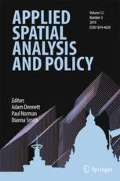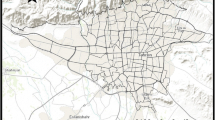Abstract
Accessibility suggests a major issue in rural areas. Remoteness or inaccessibility is known to amplify rural deprivation and suspend sustainable regional development. Many rural areas in Greece suffer from remoteness mainly because of a varying and continuously alternating terrain. A diverse space is shaped by more than 70% mountain areas, hundreds of inhabited islands in an insular area almost the size of the mainland and intense variation in population distribution between the large urban agglomerations and the periphery. In this paper, a geographical remoteness index for Greece is presented that can capture the required scale of analysis and the distinct characteristics of Greek space. The index is localized and evaluated using empirical and theoretical methods and several demographic and network geostatistics. Finally, we examine the relationship of the index and critical socioeconomic variables in order to associate accessibility with spatial inequalities. Spatial regression models are used that uncover the impact of remoteness in certain key development aspects, namely economy, human capital and infrastructures. Potentially, accessibility may be used as an evaluation tool to redirect policies for spatial equity.






Similar content being viewed by others
References
Anselin, L., Syabri, I., & Kho, Y. (2010). GeoDa: an introduction to spatial data analysis. Handbook of applied spatial analysis, 73–89.
Calver, J., Preen, D., Bulsara, M., & Sanfilippo, F. (2007). Stimulant prescribing for the treatment of ADHD in Western Australia: socioeconomic and remoteness differences. Medical Journal of Australia, 186(3), 124.
Caschili, S., De Montis, A., & Trogu, D. (2015). Accessibility and rurality indicators for regional development. Computers, Environment and Urban Systems, 49, 98–114.
Chi, G., & Zhu, J. (2008). Spatial regression models for demographic analysis. Population Research and Policy Review, 27(1), 17–42.
Coccossis, H. (2001). Sustainable development of the Greek Islands. Options Méditerranées, Serie A (44), 391–394.
Copus, A. K. (2001). From core-periphery to polycentric development: concepts of spatial and aspatial peripherality. European Planning Studies, 9(4), 539–552.
EC (2011). Exploring the potential of maritime spatial planning in the Mediterranean—Country Report: Greece. European Commission study. European Commission DG Fisheries and Maritime Affairs: European Commission.
Eckert, K. A., Taylor, A. W., & Wilkinson, D. (2004). Does health service utilisation vary by remoteness? South Australian population data and the accessibility and remoteness index of Australia. Australian and New Zealand Journal of Public Health, 28(5), 426–432.
EL.STAT. (2016a). Households, households with/without internet connection (2011 Census). Hellenic Statistical Authority (EL.STAT.). Accessed September, 2016.
EL.STAT. (2016b). Population by sex, age groups and place of birth (2011 Census). Hellenic Statistical Authority (EL.STAT.). Accessed September, 2016.
EL.STAT. (2017). Population by place of permanent residence and level of education (2011 Census). Hellenic Statistical Authority (EL.STAT.). Accessed April, 2017.
EuroGlobalMap 1:1 million scale topographic dataset (2015). EuroGeographics. http://www.eurogeographics.org/products-and-services/euroglobalmap. Accessed April, 2016.
Eurostat (2016). Urban-rural typology. eurostat statistics explained: Statistical office of the european communities.
Farmer, J. C., Baird, A. G., & Iversen, L. (2001). Rural deprivation: reflecting reality. The British Journal of General Practice, 51(467), 486–491.
Farrington, J. H. (2007). The new narrative of accessibility: its potential contribution to discourses in (transport) geography. Journal of Transport Geography, 15(5), 319–330.
Fuel prices of unleaded95 and heating oil, 2012 (2012). Ministry of finance, Development and Tourism. http://www.fuelprices.gr/. Accessed May, 2016.
GEOSTAT 2011 1km2 population grid (2012). The European Forum for GeoStatistics-Statistical Office of the European Communities.
Geurs, K. T., & Van Wee, B. (2004). Accessibility evaluation of land-use and transport strategies: review and research directions. Journal of Transport Geography, 12(2), 127–140.
Glover, J. D., & Tennant, S. K. (2003). Remote areas statistical geography in Australia: notes on the Accessibility/Remoteness Index for Australia (ARIA+ version): Public Health Information Development Unit, the University of Adelaide.
Guagliardo, M. F. (2004). Spatial accessibility of primary care: concepts, methods and challenges. International Journal of Health Geographics, 3(1), 1.
Handy, S. L., & Niemeier, D. A. (1997). Measuring accessibility: an exploration of issues and alternatives. Environment and Planning A, 29(7), 1175–1194.
Hastaoglou, V., Hadjimichalis, C., Kalogirou, N., & Papamichos, N. (1987). Urbanisation, crisis and urban policy in Greece. Antipode, 19(2), 154–177.
Heatlh Map of Greece (2008). Hellenic center for disease control & prevention (HCDCP) - ministry of health. http://ygeiamap.gov.gr. Accessed June, 2016.
Higgs, G., & White, S. (2000). Alternatives to census-based indicators of social disadvantage in rural communities. Progress in Planning, 53(1), 1–81. https://doi.org/10.1016/S0305-9006(99)00021-5.
Hoggart, K., Black, R., & Buller, H. (2014). Rural Europe: Routledge.
Kizos, T. (2007). Island lifestyles in the Aegean Islands, Greece: heaven in summer, hell in winter? In Seasonal landscapes (pp. 127–149): Springer.
Kwan, M. P. (1998). Space-time and integral measures of individual accessibility: a comparative analysis using a point-based framework. Geographical Analysis, 30(3), 191–216.
Labrianidis, L. (2006). Human capital as the critical factor for the development of Europe’s rural peripheral areas (pp. 41–59). The New European Rurality: Strategies for Small Firms.
Li, P., & Lu, Y. (2005). Review and prospectation of accessibility research. Progress in Geography, 3, 009.
McNamara, B., & Rosenwax, L. (2007). Factors affecting place of death in Western Australia. Health & Place, 13(2), 356–367.
Moran, P. A. (1950). Notes on continuous stochastic phenomena. Biometrika, 37(1/2), 17–23.
Murray, G., Judd, F., Jackson, H., Fraser, C., Komiti, A., Hodgins, G., et al. (2004). Rurality and mental health: the role of accessibility. Australian and New Zealand Journal of Psychiatry, 38(8), 629–634.
Murray, G., Judd, F., Jackson, H., Fraser, C., Komiti, A., Hodgins, G., et al. (2005). The five factor model and accessibility/remoteness: Novel evidence for person–environment interaction. Personality and Individual Differences, 39(4), 715–725.
Nordregio (2004). Mountain areas in Europe: analysis of mountain areas in EU member states, acceding and other European countries. Nordregio Report (pp. 271).
Páez, A., Scott, D. M., & Morency, C. (2012). Measuring accessibility: positive and normative implementations of various accessibility indicators. Journal of Transport Geography, 25, 141–153.
Panebianco, S., & Schürmann, C. (2002). The Egnatia Motorway–a chance for Northern Greece to catch up. In 42nd Congress of the European Regional Science Association, (Vol. 2731).
Pirie, G. H. (1979). Measuring accessibility: a review and proposal. Environment and Planning A, 11(3), 299–312.
Pooler, J. (1987). Measuring geographical accessibility: a review of current approaches and problems in the use of population potentials. Geoforum, 18(3), 269–289.
Poulos, R. G., Hayen, A., Chong, S. S., & Finch, C. F. (2009). Geographic mapping as a tool for identifying communities at high risk of fire and burn injuries in children. Burns, 35(3), 417–424.
Road Network Planning Administration (2015). National road network of Greece. Athens: General Secretary of Infrastructures, Ministry of Infrastructure, Transport and Networks.
Saitis, C., & Saiti, A. (2004). School libraries in Greece: A comparative study of public primary schools in rural and urban areas. Library & Information Science Research, 26(2), 201–220. https://doi.org/10.1016/j.lisr.2003.12.004.
Schürmann, C., & Talaat, A. (2002). The European peripherality index. In 42nd Congress of the European Regional Science Association (ERSA), Dortmund,(pp. 27–31).
Skuras, D., Dimara, E., & Vakrou, A. (2000). The day after grant-aid: business development schemes for small rural firms in lagging areas of Greece. Small Business Economics, 14(2), 125–136.
Spiekermann, K., & Neubauer, J. (2002). European accessibility and peripherality: Concepts, models and indicators.
Spiekermann, K., & Wegener, M. (2006). Accessibility and spatial development in Europe. Scienze Regionali, 5(2), 15–46.
Spilanis, I., Kizos, T., & Petsioti, P. (2012). Accessibility of peripheral regions: evidence from Aegean islands (Greece). Island Studies Journal, 7(2), 199–214.
Statistical report of tax data 2011 (2011). General secretary of information systems, Ministry of Finance, Greece. http://www.gsis.gr/gsis/info/gsis_site/PublicIssue/Statistics.html. Accessed November, 2016.
Straatemeier, T., & Bertolini, L. (2008). Joint accessibility design: Framework developed with practitioners to integrate land use and transport planning in the Netherlands. Transportation Research Record: Journal of the Transportation Research Board, 2077, 1–8.
Trewin, D. (2001). ABS views on remoteness. Australian Bureau of Statistics. Canberra, ACT: Australian Bureau of Statistics.
Van Wee, B. (2016). Accessible accessibility research challenges. Journal of Transport Geography, 51, 9–16.
Vandenbulcke, G., Steenberghen, T., & Thomas, I. (2009). Mapping accessibility in Belgium: a tool for land-use and transport planning? Journal of Transport Geography, 17(1), 39–53.
Wagstaff, P. (1999). Regionalism in the European Union: Intellect Books.
Waldorf, B. (2006). A continuous multi-dimensional measure of rurality: Moving beyond threshold measures. Selected Paper, Annual Meetings AAEA, Long Beach, CA, July 2006.
Wang, F. (2012). Measurement, optimization, and impact of health care accessibility: a methodological review. Annals of the Association of American Geographers, 102(5), 1104–1112.
Wee, B., & Geurs, K. (2011). Discussing equity and social exclusion in accessibility evaluations. European Journal of Transport and Infrastructure Research, 11(4).
Zilkens, R. R., Spilsbury, K., Bruce, D. G., & Semmens, J. B. (2009). Clinical epidemiology and in-patient hospital use in the last year of life (1990–2005) of 29,884 Western Australians with dementia. Journal of Alzheimer's Disease, 17(2), 399–407.
Acknowledgements
We would like to thank the anonymous reviewers for their valuable suggestions that greatly improved this manuscript.
Author information
Authors and Affiliations
Corresponding author
Ethics declarations
Conflict of Interest
The authors declare that they have no conflict of interest.
Rights and permissions
About this article
Cite this article
Panagiotopoulos, G., Kaliampakos, D. Accessibility and Spatial Inequalities in Greece. Appl. Spatial Analysis 12, 567–586 (2019). https://doi.org/10.1007/s12061-018-9256-8
Received:
Accepted:
Published:
Issue Date:
DOI: https://doi.org/10.1007/s12061-018-9256-8




